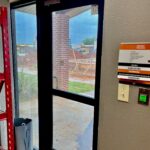 Even 5 years after moving, I still read the news from the city in Massachusetts where I previously lived for 16 years, and I was #wordless when I saw this story from the Framingham Source. I receive reader photos of blocked emergency exits on a weekly basis, but often it feels pointless to try to effect change. I worry about waiting for a tragedy to occur so people will understand why the codes exist, but even past tragedies have not resulted in lasting change. People forget, doors are locked or blocked, and it happens again.
Even 5 years after moving, I still read the news from the city in Massachusetts where I previously lived for 16 years, and I was #wordless when I saw this story from the Framingham Source. I receive reader photos of blocked emergency exits on a weekly basis, but often it feels pointless to try to effect change. I worry about waiting for a tragedy to occur so people will understand why the codes exist, but even past tragedies have not resulted in lasting change. People forget, doors are locked or blocked, and it happens again.
But here’s another incentive to comply: A news release from the US Department of Labor’s Occupational Safety and Health Administration (OSHA) states that two Massachusetts stores (including one near my old home) were recently fined $227,304 for blocked emergency exits. Almost a quarter of a million dollars.
OSHA inspectors found fire exit routes in backroom storage areas blocked by objects, such as packing boxes, products, rolling carts, metal bars, portable ladders, and a powered industrial truck.
A few years ago I looked into whether OSHA regulations are applicable to public schools, since some of the security methods being used are not compliant with OSHA requirements, adopted codes, or federal accessibility laws. Here’s what I wrote in my article, Barricade Device, Think Twice:
The Occupational Safety and Health Administration (OSHA) regulation 1926.34 prohibits devices that impede egress: “No lock or fastening to prevent free escape from the inside of any building shall be installed except in mental, penal, or corrective institutions where supervisory personnel is continually on duty and effective provisions are made to remove occupants in case of fire or other emergency.” In some states, OSHA regulations do not cover state and local government employees (including school staff), but many states adopt the OSHA regulations as part of their workplace safety requirements. In those states, the OSHA requirements for free egress may apply to schools.
For more information about OSHA requirements for keeping exits clear, refer to the agency’s Emergency Exit Routes fact sheet.
Note: I don’t have a photo of the exits addressed in this article, but there are plenty of blocked-exit photos on the Wordless Wednesday page.
You need to login or register to bookmark/favorite this content.





Soon after I started my professional job managing a large, metropolitan hospital physical plant, I was called to the administration. The 487,000 square foot building was only about 8 months old at that point in the early 1970’s. I met an OSHA inspector who had the assignment from his area office of inspecting the new facility. This was not based on a complaint but rather a desire to see what issues OSHA could find in the new building. OSHA was relatively new at that time and I toured the facility for most of a week as I recall. The inspector started by gathering together all the incident reports from opening day. He sat down at a table and read each incident report, categorizing them into piles. He focused his attention on the various incidents starting with the most potentially injurious. This was my first exposure to such an inspection by a federal officer. I have to tell you we covered everything from the speed that a mangle (power operated steam ironer probably suitably named). At the end, I had to address about a dozen issues we identified and we were fined about $125 as I recall.
The ironer was a good illustration of the subtle safety issues one can find. The ironer had two separated paddles that had to be pressed simultaneously for it to close down on the hot ironer surface. He demonstrated that it was not closing fast enough by placing a scrub shirt on it so that it would slip off – and he could get his hand under the closing ironer in reaction to the slipping garment! I would never have spotted that issue. I ended up having a better pair of eyes for safety. I only encountered one other OSHA inspector who was responding to an employee complaint about a laser used to weld retinas back in adhesion inside the eyeball. Fortunately, the laser was intended to work into the human eye by a highly trained and skilled eye surgeon, is key operated and as the physician pointed out totally aimed at a closed path into a human eye. you cannot use eye protection. I was impressed that the eye doctor used the term closed path laser which fit in very well with a safe situation. Not exactly a hardware topic. I just had to say, I was very impressed by the OSHA people I had contact with. and they have some draconian ability to fine people should the need arise.
I know I’ve said this before, Jerry, but the insight you share is so beneficial for the many people who have not had the same experiences. I really appreciate your contributions to iDigHardware!
– Lori
Hello, I have a question regarding exit discharge doors (for the sake of argument, non fire rated). It seems to me these doors should be required to be self-closing/self-latching due to the a. security issue that arises if the doors do not shut and latch upon use. Especially if an alarming panic device is installed. But, i cannot for the life of me find the requirement in any of the codes follow nationally and state wide.
However, I did find an article on OSHA website detailing a fine imposed of a non self latching exit discharge door for the potential of creating a draft through the open/non-latched exit discharge door in the event of a fire and I believe it was identified as an “obstructed exit route”.
Am I wrong when I say I don’t believe exterior exit discharge doors are not required to have a closing mechanism on them to ensure positive latch?
Thank you
Hi Anthony –
Having a self-closing and self-latching door is very important for security but I don’t know of a code requirement for that (if it’s not a fire door). Typically, the codes address egress rather than security.
– Lori
Emergency-Exit Doors Must Remain Closed
OSHA found a variety of violations at both locations, including obstructed exit routes, propped-open emergency-exit doors to enclosed stairways, blocked access to electrical panels and unmounted fire extinguishers.
“In the event of a fire, the open exit doors would allow an upward draft of air that could intensify and spread the fire,” OSHA explained. “This could potentially block employees’ egress and increase the possibility of employees trapped in a fire without the ability to exit the building.”
https://www.shrm.org/resourcesandtools/hr-topics/risk-management/pages/osha-violations-blocked-exit-routes.aspx